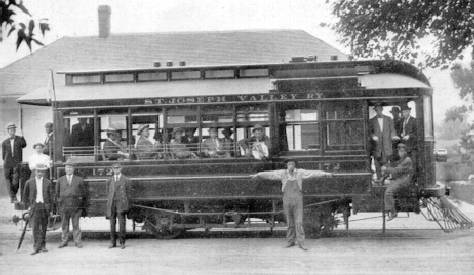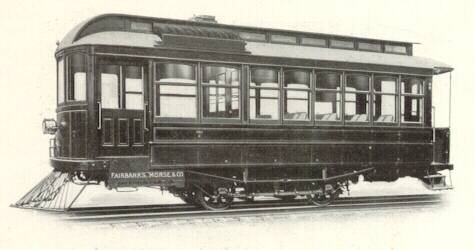Sheffield Velocipede Car Co. - Page 2
On the first day of 1910, the capital of the Sheffield Car Company was increased from $200,000 to $400,000 [more than $8 million in today’s buying power] and the following officers were elected:
At that time the company occupied 40 acres in the Second ward of the southern part of Three Rivers, and reportedly produced “light motor cars (up to the size of a street car) and . . . dump cars, mining cars, marine engines, stand pipes, electrical machinery, and an endless variety of drills and track tools.” {366} Its letterhead said “Manufacturers of Light Cars for all Purposes.” {377} During the years under Fairbanks-Morse control, Sheffield absorbed or otherwise came to control several other businesses, including {366}
Several sources say Sheffield ceased operations about 1912, but we have found at least one reference that suggests it was still “the big industry of the town [of Three Rivers]” in early 1915, and another that says Raymond Linsley [son of E.B. Linsley] became general manager of the Sheffield Car Co. in that year. {309} Though Sheffield had been firmly in the control of Fairbanks, Morse & Company since 1888, when Charles H. Morse bought out Warren Willits’ interest, in 1918 if formally became a part of the Fairbanks-Morse company. The 1924 city directory for Three Rivers, in an “historical” section, under the date of 1918 says “Sheffield Car Company designated by Government as an essential industry necessary to win the [1st World] war,” then under the date of 1919 says “Fairbanks-Morse Co. paved Fourth Street.” And all other references thereafter are to Fairbanks-Morse (Sheffield Works). And a correspondent points out that page 438 of the 1928 Car-Builders’ Cyclopedia shows motorcars, handcars and velocipedes with individual captions “Sheffield No. 44 Motor car” etc. but with a label at the bottom of the page saying “Fairbanks, Morse & Company.” And finally, the 1924 Three Rivers directory {313} lists
In 1925, Sheffield was one of 17 car builders that went to the Interstate Commerce Commission alleging unfair competition from the railroads in opening plants to rebuild and repair freight cars, and petitioning it to 1) stop encouraging the railroads to do these repairs in-house, and 2) requesting it to mandate a new accounting system that they contended would reveal the railroads were doing this work at a loss. {406} The complaining companies were —
Cast of Characters —George Solyman Sheffield (1831-1914) was born in Geneva, New York. At age 21, he began working as a carpenter. The family moved to Michigan a few years later. In 1860, he was living at Nottawa, Michigan, about 7 miles east of Three Rivers, and was employed as a cabinet maker. {374} During the Civil War, Sheffield served as a Private in Company A, 11th Michigan Infantry, with which he participated in 14 important battles. He was mustered out 29 September 1864 at Sturgis, Michigan, about 15 miles southeast of Three Rivers. {368} Following the war, Sheffield spent seven years on a farm, {368} apparently at Bronson, Michigan, roughly 20 miles east of Three Rivers, as it was there the census taker found him at the time of the 1870 census. His occupation is listed as cabinet maker. {375} In February 1871 Sheffield located just outside Three Rivers, and went to work for pump maker Willis [sic] & Hagen. {368} It appears that it was in order to commute to this job that he devised his three-wheeled vehicle. Sheffield patented his vehicle in 1879, and entered into a partnership to manufacture his car. According to one local history, he “sold a half interest for a half interest in a pump factory.” {368} Combining the facts that (1) Sheffield went into business with Warren Willets, and (2) at the time of the 1880 census he was living at Three Rivers, in the household of Warren Willits’ father Jonathan Willits, {369} it is reasonable to suggest that the pump maker for which he went to work, and for a half interest in which he traded a half interest in his new business was Willits [with a “T”] & Hagen. According to the same local history, Sheffield sold his interest in the pump manufactory four years later, and as of the date of that history (1911) it was called “Willis & Lindsey.” [Is it possible this should be Willits & Linsley? . . . Possibly the same E.B. Linsley who became a partner in the car-building business? It is entirely possible, as the writer has demonstrably misunderstood other names and/or spelled them several different ways, sometimes within the same article.] In 1891, Sheffield either withdrew from, or was forced out of, the company he had founded. He thereafter associated himself with A.C. Himebaugh [Heimbaugh?], head of the First National Bank, and in 1898 they incorporated their business as the Sheffield Manufacturing Company, with Heimbaugh as president, Sheffield as vice-president, and Arch Himebaugh (1867-1952) as secretary/treasurer. With capital of just $50,000, they built their main plant building at Burr Oak, Michigan, in 1902. Sheffield designed and built most of the machinery employed by the company. Their product line included a hand corn planter patented by Sheffield, hand potato planters, garden cultivators, and steel hand sleds. {367} Besides their partnership in the Sheffield Manufacturing Company, Sheffield and Himebaugh organized the First National Bank of Burr Oak, with Himebaugh as president. Sheffield was a Director, owned a half interest in the bank, and owned the bank building. {368} In 1900, at age 69, Sheffield was living at Burr Oak, Michigan, southeast of Three Rivers, and gave the census taker his occupation as “Fin. of Sheffield Mfg. Co.” [“Firm of?” or “Financial officer?” Your guess is as good as ours, but whatever it is, he indicates “Months Not Employed” is zero.] Ten years later (1910), at age 79, he was still living at Burr Oak, and gave no occupation, though the Sheffield Manufacturing Company was still going strong in 1911. {367} Warren J. Willits (1852-1910+) was born at [most likely Three Rivers], Michigan. He may have attended the University of Michigan at Ann Arbor. He was apparently a person of some means, though we don’t yet know how he acquired it. The year after Willits sold his interest in Sheffield Velocipede Car Company to Charles H. Morse (1888), when the Three Rivers Light & Power Company installed an electric lighting system for the city, he was president of that Company [and E.B. Linsley was its treasurer]. Three years later (1891) he participated in the organization of the First State Savings Bank and became its president. {308} He remained its president until he went to California in 1902. {370} We found Warren J. Willits in the 1910 census in Santa Barbara County, California, occupation “Own Income” [i.e., retired]. {371} Edward Baldwin Linsley (1847-1914) was born at Henrietta, New York, a descendant of a long line of Linsleys in America. About 1857, his family moved to Kalamazoo, Michigan, and about 1867 to Three Rivers. After working four years as a clerk in the drug store of Wing & Major, he formed a partnership with Ashbel W. Snyder to open their own drug store under the name of Snyder & Linsley In 1881, Linsley became a principle in the firm of George S. Sheffield & Company. When it was incorporated in 1882, he became secretary/treasurer, a position he held until 1902, when he became general manager of the company, {311} a position he held until sometime after 1910, {372} and possibly until his death. Linsley was a member of the Three Rivers Board of Education for many years. He participated in the organization of the Three Rivers Building & Loan Association in 1887 and became its first president. In 1888, he was elected mayor of the city of Three Rivers, which he served one term. When the Sheffield Car Company was reorganized in 1892, he continued as secretary and treasurer. {311} In 1904, Linsley was elected a state senator from the 6th district. He was re-elected and served in this position through 1908. He was actively identified with the Michigan National Guard for a number of years, and is given great credit for establishing the Three Rivers Public Library. {311} Raymond Burch Linsley (1885-1915+), son of Edward B. Linsley, was born at Three Rivers. {308} In 1910, he was purchasing agent for the Sheffield company. {372} In 1915, he became its general manager. {308} It appears he left Sheffield when it was acquired by Fairbanks-Morse in 1918. Return to page 1 |

